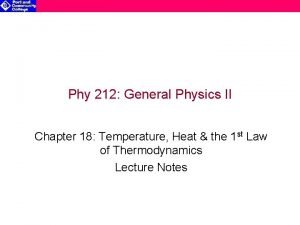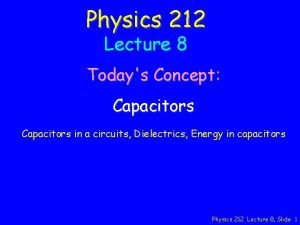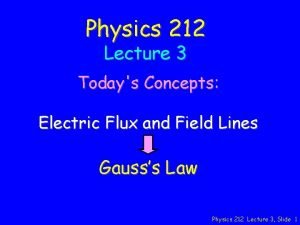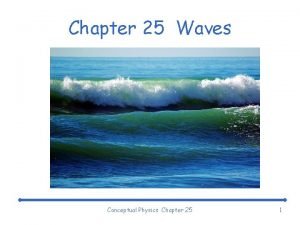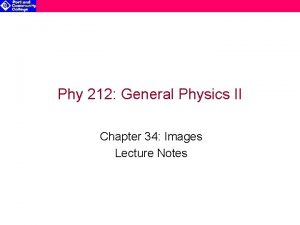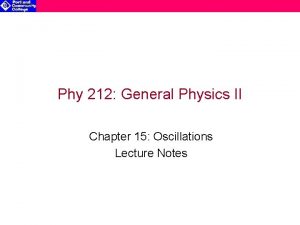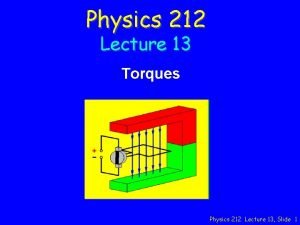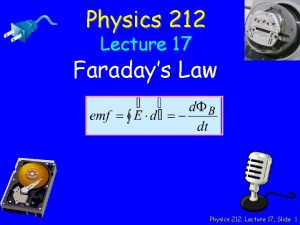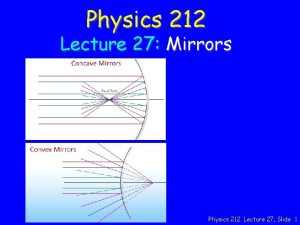Phy 212 General Physics II Chapter 16 Waves












- Slides: 12

Phy 212: General Physics II Chapter 16: Waves I Lecture Notes

Types of Waves Types of waves: a. Mechanical waves b. Electromagnetic waves c. Matter waves Classifying Waves: 1. Transverse Waves: oscillate perpendicular to the direction of wave propagation (examples: Light & E-M waves) 2. Longitudinal Waves: oscillate parallel to the direction of wave propagation (example: Sound)

General Character of Traveling Waves All traveling waves exhibit fundamental properties that are useful for describing their behavior: 1. Wave speed (vwave) refers to the rate of travel of the wave as it propagates through a medium vwave= lf vwave 2. Wavelength (l) refers to the displacement traveled by a position along the wave during 1 period of oscillation (T) T l Position (m) 3. Frequency (f) is the time rate of complete “vibration cycles” as a wave passes through a given point in a medium 1 cycle Time (s)

Traveling Waves General form for the disturbance producing a traveling wave: Transverse Velocity: Velocity Amplitude: Acceleration: Acceleration Amplitude:

Simple Model: A Traveling Wave in a String A stretched string, with constant linear mass density (m) and string tension (FT), provides a simple demonstration of the motion of a traveling wave FT FT vwave 2 FT-y y(t)

Wave speed on Stretched String 1. 2. 3. 4. When a transverse disturbance travels along a taut string, the motion (transverse to the string) of any given segment of mass along the string oscillates in simple harmonic motion. The tension (FT ) in the string functions as an “elastic” force resulting in a traveling wave The linear mass density (m, in kg/m) of the string acts as the inertial element for the string which restricts the wave propagation. The wave speed along a string is therefore expressed as: Derivation:

Energy Transmission (Power) in Waves As a wave travels along the string, the total energy (d. Etot) for a string mass segment of length, dx, is the combination of both its K and U: where: The average energy is: where: d. K(t)avg = d. U(t)avg The average power is:

The Wave Equation 1. The motion of a traveling wave is dependent on both time and position: 2. This equation (and all equations) that describe traveling wave motion, must satisfy the wave equation:

Superposition of Waves & Interference Waves of the same type that cross paths do not alter the other. • They do appear to combine to produce a resulting wave that is a superposition of each wave. • For 2 identical waves (y 1 and y 2) that are out of phase, the resultant wave is given by: • The resultant wave is itself sinusoidal and its magnitude is depends on the phase difference between y 1 and y 2

Phasors are analogous to vectors and are useful for analyzing the superposition of same frequency traveling waves: y’ 1. A phasor is a vector representation of the magnitude (length) and phase (angular direction) for a wave 2. When 2 or more waves undergo interference, y 1 the magnitude and phase of the resultant (superimposed) wave can be determined by the vector addition of the corresponding phasors a. b. y 3 y 2 The resultant phasor magnitude is the magnitude of resultant wave The resultant phasor angle is the phase angle of resultant wave

Standing Waves in a String 1. Standing waves are self-reinforcing waves produced by the constructive interference of a wave with its reflection. 2. Consider a wave traveling along a string (fixed at each end). When the wave reaches the end of the string it reflects back in the opposite direction (180 o out of phase). 3. The wave will produce a standing wave if the nodes for the resultant wave are stationary Condition for a standing wave: where: L is length of string n is the number of ½ wavelengths (l) n=1 n=2 n=3

Standing Wave Superposition
 Examples of convection
Examples of convection Physics 212 gradebook
Physics 212 gradebook Physics 212 gradebook
Physics 212 gradebook Chapter 25 concept review physics waves
Chapter 25 concept review physics waves Difference between electromagnetic and mechanical waves
Difference between electromagnetic and mechanical waves Light is an electromagnetic wave true or false
Light is an electromagnetic wave true or false Examples of mechanical waves
Examples of mechanical waves Difference between electromagnetic and mechanical waves
Difference between electromagnetic and mechanical waves The wave chapter 13
The wave chapter 13 Whats a reflected sound wave
Whats a reflected sound wave Short wave vs long wave radiation
Short wave vs long wave radiation Difference between matter waves and electromagnetic waves
Difference between matter waves and electromagnetic waves Examples of mechanical and electromagnetic waves
Examples of mechanical and electromagnetic waves
